Isanopus
Stylianos Chatzimanolis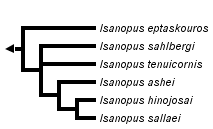


This tree diagram shows the relationships between several groups of organisms.
The root of the current tree connects the organisms featured in this tree to their containing group and the rest of the Tree of Life. The basal branching point in the tree represents the ancestor of the other groups in the tree. This ancestor diversified over time into several descendent subgroups, which are represented as internal nodes and terminal taxa to the right.

You can click on the root to travel down the Tree of Life all the way to the root of all Life, and you can click on the names of descendent subgroups to travel up the Tree of Life all the way to individual species.
For more information on ToL tree formatting, please see Interpreting the Tree or Classification. To learn more about phylogenetic trees, please visit our Phylogenetic Biology pages.
close boxIntroduction
The xanthopygine genus Isanopus occurs in tropical and montane rainforests from Mexico to Brazil. The genus is rare in collections and this may be due to the habitat preferences of the species. Most recent materials have been collected in treefall litter, with a very small number of specimens (less than ten) collected in flight intercept or malaise traps.
Characteristics
Isanopus can be distinguished from all other xanthopygine staphylinids by the following characters:
- antennomeres 5–10 are elongate and slender, typically at least 2.5 times longer than wide, although in I. sahlbergi and I. eptaskouros less than that
- paramere reduced, generally less than half the length of the median lobe
- the punctuation pattern of the pronotum: the midline of the pronotum is impunctate and there is a single row of punctures on each side of the midline separated by a distance of at least 2–3 punctures from the more lateral rows, the distance between those rows small, usually 0.5–1 puncture, and the antero-lateral parts of the pronotum are densely punctuated
 Click on an image to view larger version & data in a new window
Click on an image to view larger version & data in a new window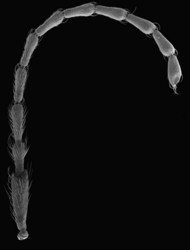
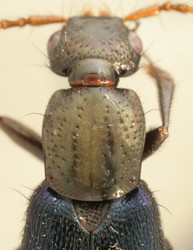
From left to right: antennae of I. ashei and punctuation pattern of I. hinojosai © 2008 Stylianos Chatzimanolis
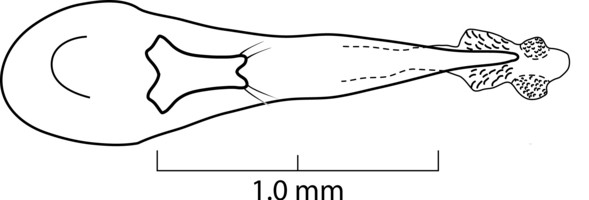
Aedeagus of I. ashei showing the reduced paramere. © 2008 Stylianos Chatzimanolis
Isanopus looks superficially similar to some species of Xanthopygus (for example: X. alienus Bernhauer, 1905, X. calidus (Erichson, 1839), X. chrysopygus (Nordmann, 1837), X. cyanelytrius (Perty, 1830), X. elegans Bernhauer, 1905 and X. flohri Sharp, 1884) but can be easily distinguished from them by the general morphology of the head (in Xanthopygus the temporal area posterior to the eyes greatly expanded), as well as the other diagnostic characters of the genus. Additionally, Oligotergus mexicanus (Sharp, 1884) and O. prolixus (Sharp, 1884) have superficially similar antennae, but they can be easily distinguished from Isanopus by the usually densely punctuated pronotum, and the shape of the aedeagus with the paramere considerably longer than the median lobe.
Discussion of Phylogenetic Relationships
A phylogenetic analysis of 19 adult morphological characters from six ingroup taxa resulted in a single most parsimonious tree (Chatzimanolis 2008). Isanopus is robustly hypothesized to be monophyletic with high bootstrap and Bremer support values. Despite the absence of any homoplasy on the tree, the characters used in the analysis do not provide enough phylogenetic resolution to determine the position of I. sahlbergi and I. tenuicornis. It is worth mentioning here that I. ashei, I. hinojosai and I. sallaei are distributed exclusively in Central America in contrast to the three other species of Isanopus that are distributed in South America.
References
Chatzimanolis S. 2008. A revision of the neotropical beetle genus Isanopus Sharp, 1876 (Coleoptera: Staphylinidae: Staphylinini). J. Nat. Hist. 42(25-28): 1765-1792.
Title Illustrations

| Scientific Name | Isanopus ashei |
|---|---|
| Specimen Condition | Dead Specimen |
| Identified By | S. Chatzimanolis |
| Sex | Male |
| Image Use |
 This media file is licensed under the Creative Commons Attribution-NonCommercial License - Version 3.0. This media file is licensed under the Creative Commons Attribution-NonCommercial License - Version 3.0.
|
| Copyright |
© 2008 Stylianos Chatzimanolis

|
| Scientific Name | Isanopus hinojosai |
|---|---|
| Specimen Condition | Dead Specimen |
| Identified By | S. Chatzimanolis |
| Sex | Male |
| Image Use |
 This media file is licensed under the Creative Commons Attribution-NonCommercial License - Version 3.0. This media file is licensed under the Creative Commons Attribution-NonCommercial License - Version 3.0.
|
| Copyright |
© 2008 Stylianos Chatzimanolis

|
About This Page
Stylianos Chatzimanolis

University of Tennessee at Chattanooga
Correspondence regarding this page should be directed to Stylianos Chatzimanolis at
Page copyright © 2009 Stylianos Chatzimanolis
 Page: Tree of Life
Isanopus.
Authored by
Stylianos Chatzimanolis.
The TEXT of this page is licensed under the
Creative Commons Attribution License - Version 3.0. Note that images and other media
featured on this page are each governed by their own license, and they may or may not be available
for reuse. Click on an image or a media link to access the media data window, which provides the
relevant licensing information. For the general terms and conditions of ToL material reuse and
redistribution, please see the Tree of Life Copyright
Policies.
Page: Tree of Life
Isanopus.
Authored by
Stylianos Chatzimanolis.
The TEXT of this page is licensed under the
Creative Commons Attribution License - Version 3.0. Note that images and other media
featured on this page are each governed by their own license, and they may or may not be available
for reuse. Click on an image or a media link to access the media data window, which provides the
relevant licensing information. For the general terms and conditions of ToL material reuse and
redistribution, please see the Tree of Life Copyright
Policies.
- First online 04 January 2009
- Content changed 04 January 2009
Citing this page:
Chatzimanolis, Stylianos. 2009. Isanopus. Version 04 January 2009. http://tolweb.org/Isanopus/10272/2009.01.04 in The Tree of Life Web Project, http://tolweb.org/





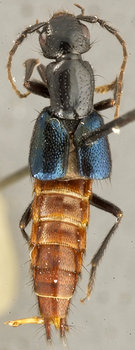
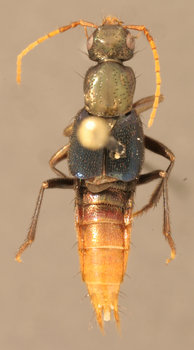



 Go to quick links
Go to quick search
Go to navigation for this section of the ToL site
Go to detailed links for the ToL site
Go to quick links
Go to quick search
Go to navigation for this section of the ToL site
Go to detailed links for the ToL site